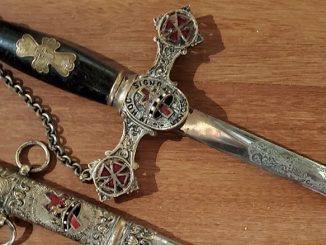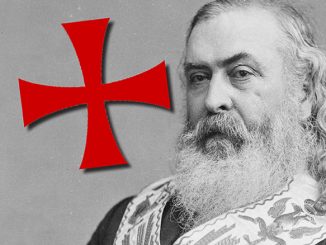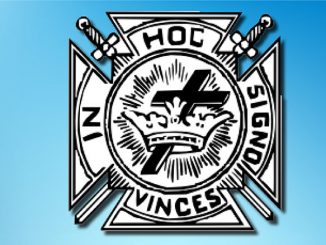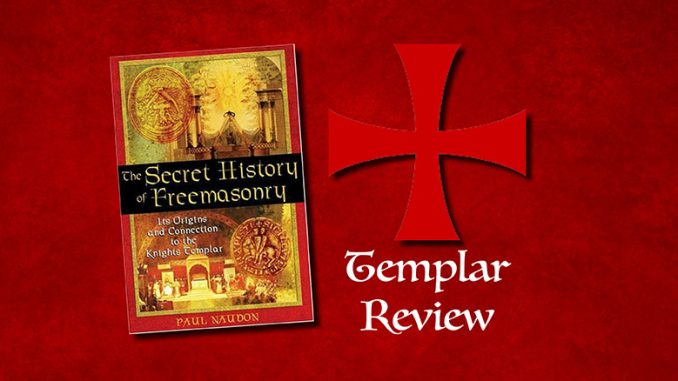
Order The Secret History of Freemasonry: Its Origins and Connection to the Knights Templar from amazon.com.
By Paul Naudon
Paperback: 320 pages
Publisher: Inner Traditions
Language: English
ISBN: 159477028X
Reviewed by Michael Bayrak
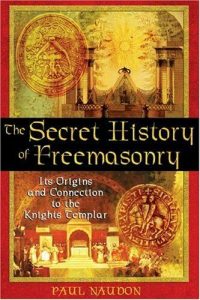 This book was first published in 1991 in French and finally translated into English and published in 2005. The majority of the book deals with the history of operative masonry in Europe, particularly in France, and how it developed from the Roman Collegia to the guilds of cathedral builders under the auspices of the Church. The author delves into the details of Templar place names throughout France and Paris, including those of buildings, towns, and roads, and describes the relationship between the operative masons, known as “francs-meitres”, and the many other trades then in existence.
This book was first published in 1991 in French and finally translated into English and published in 2005. The majority of the book deals with the history of operative masonry in Europe, particularly in France, and how it developed from the Roman Collegia to the guilds of cathedral builders under the auspices of the Church. The author delves into the details of Templar place names throughout France and Paris, including those of buildings, towns, and roads, and describes the relationship between the operative masons, known as “francs-meitres”, and the many other trades then in existence.
When the Knights Templar and Holy Church built all these cathedrals and edifices to God, stone masons were obviously hired to do the work, as were other trades. While both the Templars and the Church sponsored such endeavours, he explains that the knowledge of the work was passed down through educated clergymen. But how the work was completed and managed seemed to be left to the workers and masters. They were “free” to work and travel, and therefore, organized themselves accordingly in order to set standards.
He emphasizes the fact that what made masonry special in a religious and esoteric sense, and perhaps unique from the other trades, is in the nature of the work itself. The worker truly believed that God expressed His Will through these physical efforts and that perfection was a requirement to build and erect these holy palaces of worship to Him. This is where the author convinced me that speculative Masonry was already engrained into the hearts and minds of the operative masons. In fact, he goes as far as saying there were already speculative Masons at the time when the infamous Regius Manuscript was written, and even before that with the 10th century York at the time of King Athelstan (c.895 – 939 A.D.).
As the mason companies and brotherhoods in France were disbanded by the King, the author admits that the real transition from operative lodges into speculative occurred more or less in England and Scotland. He briefly mentions William St. Clair as the hereditary Grand Master of Scotland, but does not talk about the Sinclairs and Rosslyn Chapel.
The esoteric side of Masonic ritual development in the 18th century is generally explained as originating from Christian allegories. Performances and plays depicting Biblical stories were common in England and Scotland for some time, but the Church had forbidden any Passion Week plays or ones on the Crucifixion and Resurrection. With this, he implies that the Hiramic Legend, derived from the earlier Noachide Legend, is one of these substituted Christian allegorical plays. The building of the Temple of Solomon was simply a popular Old Testament story that was a natural fit with operative masonry giving it the religious legitimacy and Almighty Approval the operative worker so believed.
The author never states emphatically that the Templars had any direct influence on the organization or esoteric aspect of early operative masonry or later 18th century speculative ritual, but that it was the general influence of the common Christian faith and stories.
In the last few chapters, the book explains the history of Masonry in relation to the political and religious circumstances in England, Scotland, and France, as seems standard in Masonic history works. He touches on �cosse (so-called “Scottish”) Masonry in France, but stays focused on saying that the numerous higher degrees were inspired by Ramsey’s claim of Masonic chivalric origins. Recently, there have been many non-fictional and fictional books and films written on Templar history and its influence on the formation of Freemasonry. It’s perhaps this romanticism that has fueled its popularity, but again, a claim that has not yet been directly proven.
The conclusion of the book does not summarize historical findings, but rather, gives a beautifully worded, yet cryptic lecture, which appears to speak directly to a cognitive Mason reading it. Naudon concludes that Freemasonry has prevailed because of the few members who truly understand its core purpose and true history. Freemasonry has prevailed, Naudon tells us, because of the soul of the operative brother who simply believed that the perfection of his work was due to direct Divine Influence. His spiritual insight into the relationship of the trade’s symbolism is what inspires him to be a faithful man of just and upright intentions, and not from knowing that he’s an implied descendant of crusader knights or Egyptian priests. This continual deviation from the true path, Naudon argues, will denigrate its inherent beauty and cause the order’s demise into the dust of history.
For a book published in 1991, how true those sentiments are in relation to Freemasonry’s current status. For an ancient order that teaches one to “know thyself while it is yet day”, due to its decreasing stature, it appears that there are those who claim Freemasonry for themselves while entirely missing the mark behind its true purpose and aim, but if there are those Masons who remain hopeful, who have faith and love, it can resurrect itself from the ashes.
I am wondering if the title of the book, while appearing sensational to the conspiracy theorist, is not subconsciously providing a means to understanding its very own raison d’etre, that is, causing the reader to reflect on what the secret of Freemasonry is.
You may now be tempted to read that conclusion first, but after toiling and learning about the history of operative masonry in the first part of the book you will certainly appreciate it, as a true initiate would. Because the conclusion of the book was so powerfully enlightening for me, I give the book a 4 out of 5. The rating is one point short of perfection as there were some dry parts, and since the work was translated, some of the historical concepts were not as clear as I hoped, and the author rammed a lot of information into some chapters making it a difficult book to navigate. Otherwise, I would highly recommend this book to the already historically educated Mason as it will reset your bearings and hopefully inspire you.
Order The Secret History of Freemasonry: Its Origins and Connection to the Knights Templar from amazon.com.
About Us
We hope you enjoyed this review of The Secret History of Freemasonry
TemplarHistory.com was started in the fall of 1997 by Stephen Dafoe, a Canadian author who has written several books on the Templars and related subjects.
Read more like Secret History of Freemasonry from our Templar Reviews & Interviews Archives – Templar History

